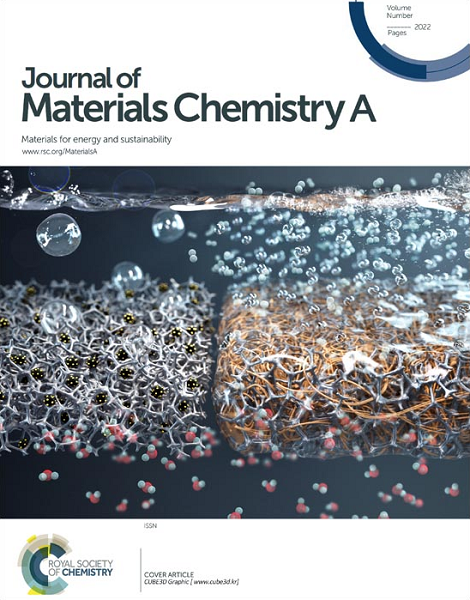Failure of Protonic Ceramic Fuel Cells (PCFCs) Under Gaseous Cr and CO2 Exposure and the Introduction of Protective Barrier Layer for Mitigation
IF 10.7
2区 材料科学
Q1 CHEMISTRY, PHYSICAL
引用次数: 0
Abstract
Protonic ceramic fuel cells (PCFCs) are attracting widespread interest due to their high efficiency and relatively low operating temperatures. However, the stability of PCFCs under realistic operating conditions, which include exposure to volatile Cr species and CO2 in the air electrode compartment, has rarely been examined. Here, we test a PCFC composed of BaCe0.4Zr0.4Y0.1Yb0.1O3-δ as the electrolyte and PrBa0.5Sr0.5Co1.5Fe0.5O5+δ as the air electrode, with a metallic interconnect and atmospheric air as an oxidant gas. The complete phase decomposition of the electrolyte and the formation of BaCO3 at the air electrode/electrolyte interface were observed after sudden cell failure within 20 hours of operation. Detailed analyses and control tests confirm the effects of Cr and CO2 species on cell degradation. In contrast, the PBSCF air electrode remains relatively stable. We also report on the effectiveness of applying a thin and dense PBSCF protective barrier layer between the electrolyte and the air electrode, which significantly improves stability under realistic operating conditions.质子陶瓷燃料电池(pcfc)在气态Cr和CO2暴露下的失效及其防护屏障层的引入
质子陶瓷燃料电池(pcfc)由于其高效和相对较低的工作温度而引起了广泛的关注。然而,pcfc在实际操作条件下的稳定性,包括暴露于挥发性Cr物质和空气电极室中的CO2,很少被检查。本文测试了以BaCe0.4Zr0.4Y0.1Yb0.1O3-δ为电解液,以PrBa0.5Sr0.5Co1.5Fe0.5O5+δ为空气电极,金属互连,大气为氧化气体的PCFC。电池突然失效后,在20小时内观察到电解液的完全相分解和BaCO3在空气电极/电解液界面的形成。详细的分析和对照试验证实了Cr和CO2对细胞降解的影响。相比之下,PBSCF空气电极保持相对稳定。我们还报道了在电解质和空气电极之间施加薄而致密的PBSCF保护阻挡层的有效性,这显着提高了实际操作条件下的稳定性。
本文章由计算机程序翻译,如有差异,请以英文原文为准。
求助全文
约1分钟内获得全文
求助全文
来源期刊

Journal of Materials Chemistry A
CHEMISTRY, PHYSICAL-ENERGY & FUELS
CiteScore
19.50
自引率
5.00%
发文量
1892
审稿时长
1.5 months
期刊介绍:
The Journal of Materials Chemistry A, B & C covers a wide range of high-quality studies in the field of materials chemistry, with each section focusing on specific applications of the materials studied. Journal of Materials Chemistry A emphasizes applications in energy and sustainability, including topics such as artificial photosynthesis, batteries, and fuel cells. Journal of Materials Chemistry B focuses on applications in biology and medicine, while Journal of Materials Chemistry C covers applications in optical, magnetic, and electronic devices. Example topic areas within the scope of Journal of Materials Chemistry A include catalysis, green/sustainable materials, sensors, and water treatment, among others.
 求助内容:
求助内容: 应助结果提醒方式:
应助结果提醒方式:


